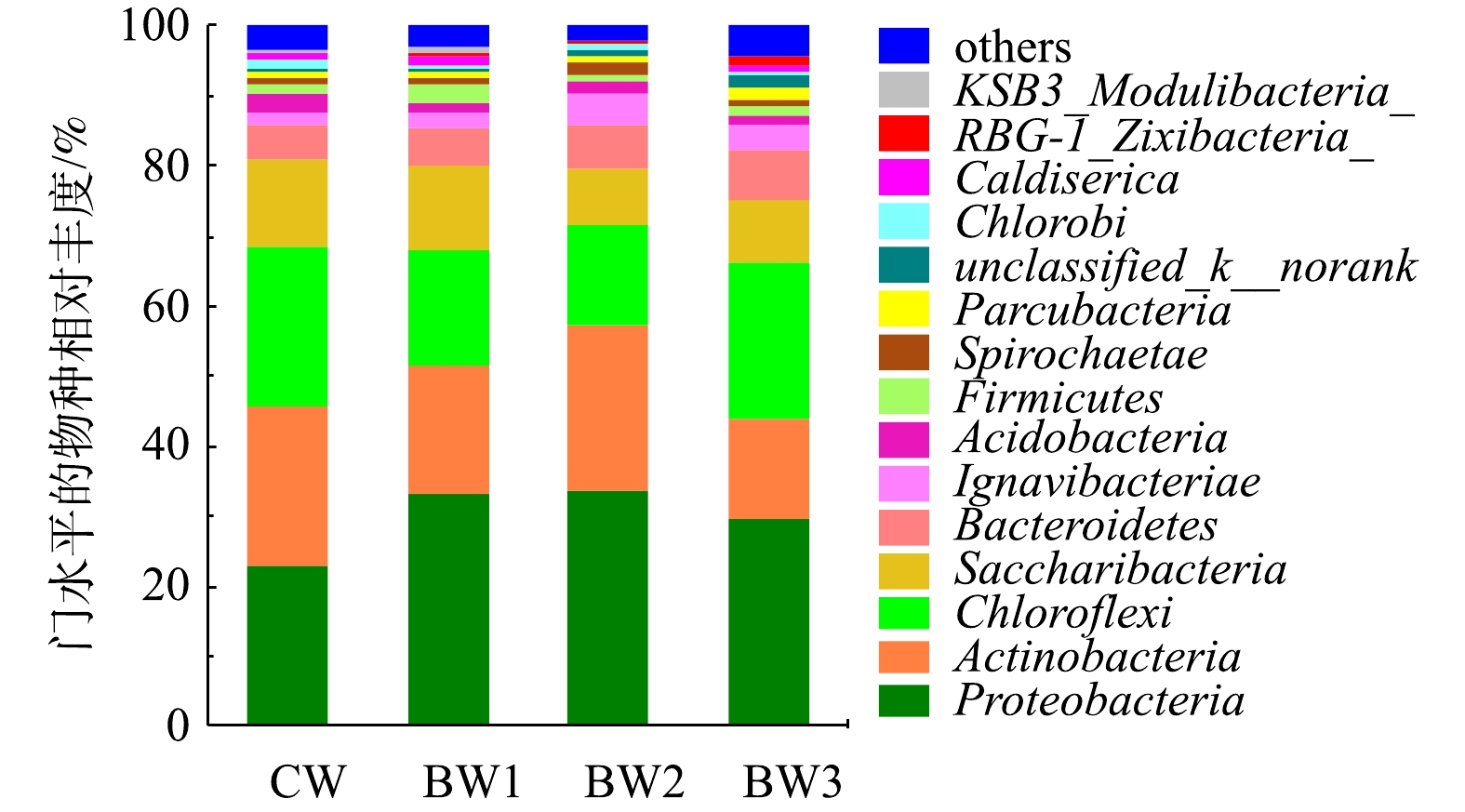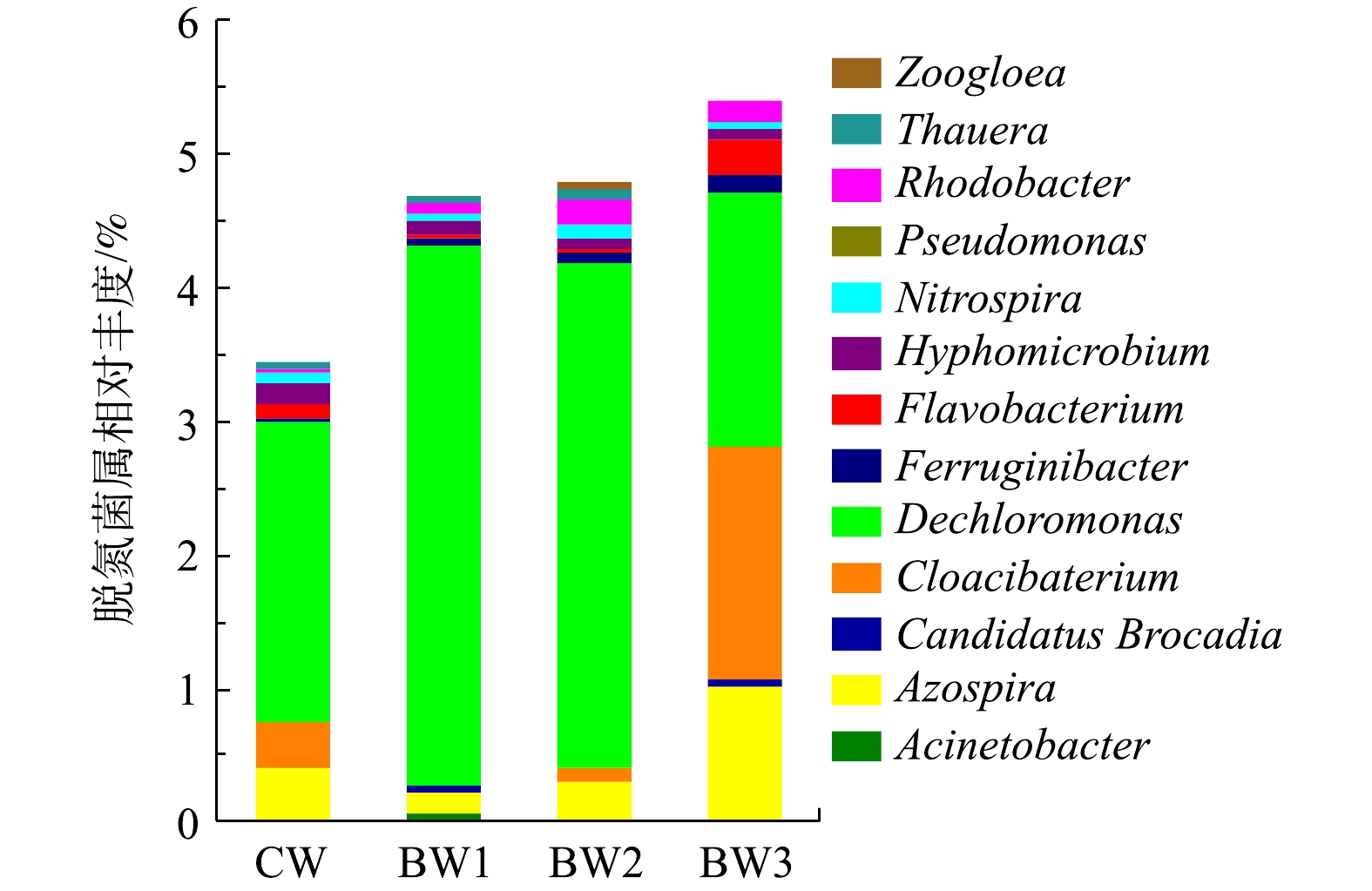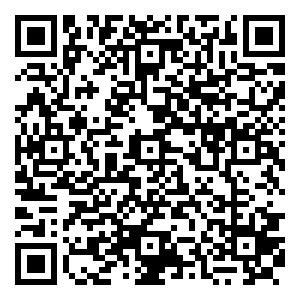3.农村清洁工程重庆市工程研究中心,重庆 400716
1.Key Laboratory of Eco-Environments in Three Gorges Reservoir Region (Ministry of Education), Southwest University, Chongqing 400716, China
2.College of Resources & Environment, Southwest University, Chongqing 400715, China
3.Chongqing Engineering Research Center of Rural Cleaning, Chongqing 400716, China
生物炭作为一种疏松多孔的吸附材料,近年来被广泛应用于受污染水体净化。通过构建生物炭投加比为0、10%、30%和40%的间歇曝气湿地系统(分别命名为CW、BW1、BW2和BW3),探究了生物炭投加比例对间歇曝气湿地中污染物去除及微生物群落结构的影响。结果表明,投加生物炭可提高湿地系统曝气段水体中平均溶解氧(DO)浓度。其中,BW3曝气段平均DO浓度为2.5 mg·L
>0.05)。所有湿地系统水体中化学需氧量(COD)去除率均高于90%,生物炭添加对耗氧有机物去除的影响并不显著。当生物炭投加比例由0增加至40%时,氨氮的去除率由80.76%提高至99.43%。生物炭可以显著提升湿地系统总氮的去除效果,BW3的总氮去除率相较于空白对照提高了18.5%,且在各反应器出水中均未检测到硝态氮(
等10余种与脱氮相关的菌落丰度。在间歇曝气湿地系统中,生物炭可以通过增加脱氮相关菌属,提高对氮素污染物的净化效果。
Biochar, as a kind of porous adsorption material, has been widely used in wastewater treatment in recent years. In this study, four groups of miniature intermittent aerated wetlands were constructed with different biochar doses of 0%, 10%, 30% and 40% (named as CW, BW1, BW2, and BW3, respectively) to investigate the effects of biochar on pollutant removal characteristics and microbial community structure. The results showed that adding biochar could increase the average dissolved oxygen (DO) concentration in the aeration section, but had no significant effect on the DO concentration in the intermittent section(
>0.05). The average DO concentration in aeration section of BW3 was 2.5 mg·L
, which was 13.6% higher than that in CW. Since the removal rates of chemical oxygen demand (COD) in all systems were above 90%, biochar induction had no significant effect on organic matter removal. With the proportion of biochar increasing from 0% to 40%, the removal rate of
-N increased from 80.76% to 99.43%. Compared to the control, TN removal of intermittent aerated wetlands could be significantly improved by adding biochar, and the removal rate in BW3 was 18.5% higher than that of control. Additionally,
-N was not detected in effluent. Illumina MiSeq sequencing results revealed that the dominant phyla,
decreased accordingly. About 13 denitrification bacterial species were detected in the experimental microcosms, and the relative abundance of more than ten kinds of denitrification bacteria, including
was elevated by adding biochar. Thus, biochar addition can improve the removal of nitrogen by altering microbial community and increasing the relative abundance of denitrifying functional bacteria in the intermittent aerated constructed wetland. The results can provide new insights into the use of biochar in the enhancement of nitrogen removal of microbial community.
.
Scheme of the experimental microcosm
Changes of DO and pH in different constructed wetlands during the experimental period
-N and TN in different constructed wetlands during the experimental period
Microbial community composition at phylum level
Differences in microbial communities at the genus level
Relative abundances of nitrogen removal microbial community at genus level
| [1] | LIU F F, FAN J L, DU J H, et al. Intensified nitrogen transformation in intermittently aerated constructed wetlands: Removal pathways and microbial response mechanism[J]. Science of the Total Environment, 2019, 650: 2880-2887. |
| [2] | 王宁, 黄磊, 罗星, 等. 生物炭添加对曝气人工湿地脱氮及氧化亚氮释放的影响[J]. 环境科学, 2018, 39(10): 4505-4511. |
| [3] | LIANG B, LEHMANN J, SOLOMON D, et al. Black carbon increases cation exchange capacity in soil[J]. Soil Science Society of America Journal, 2006, 70(5): 1719-1730. |
| [4] | ZHOU X, LIANG C L, JIA L X, et al. An innovative biochar-amended substrate vertical flow constructed wetland for low C/N wastewater treatment: Impact of influent strengths[J]. Bioresource Technology, 2018, 247: 844-850. |
| [5] | SUN Y F, QI S Y, ZHENG F P, et al. Organics removal, nitrogen removal and N2O emission in subsurface wastewater infiltration systems amended with/without biochar and sludge[J]. Bioresource Technology, 2018, 249: 57-61. |
| [6] | 于小彦, 杨艳芳, 张平究, 等. 不同水分条件下生物质炭添加对湿地土壤微生物群落结构的影响[J]. 生态与农村环境学报, 2019, 35(9): 1163-1171. |
| [7] | DENG C R, HUANG L, LIANG Y K, et al. Response of microbes to biochar strengthen nitrogen removal in subsurface flow constructed wetlands: Microbial community structure and metabolite characteristics[J]. Science of the Total Environment, 2019, 694: 133678. |
| [8] | HUANG L, CHEN Y C, LIU G, et al. Non-isothermal pyrolysis characteristics of giant reed (Arundo donax L.) using thermogravimetric analysis[J]. Energy, 2015, 87: 31-40. |
| [9] | 国家环境保护总局. 水和废水监测分析方法[M]. 4版. 北京: 中国环境科学出版社, 2002. |
| [10] | BRASSARD P, GODBOUT S, RAGHAVAN V. Soil biochar amendment as a climate change mitigation tool: Key parameters and mechanisms involved[J]. Journal of Environmental Management, 2016, 181: 484-497. |
| [11] | ZHOU X, WANG X Z, ZHANG H, et al. Enhanced nitrogen removal of low C/N domestic wastewater using a biochar-amended aerated vertical flow constructed wetland[J]. Bioresource Technology, 2017, 241: 269-275. |
| [12] | EYKELBOSH A J, JOHNSON M S, COUTO E G. Biochar decreases dissolved organic carbon but not nitrate leaching in relation to vinasse application in a Brazilian sugarcane soil[J]. Journal of Environmental Management, 2015, 149: 9-16. |
| [13] | CUI X Q, HAO H L, ZHANG C K, et al. Capacity and mechanisms of ammonium and cadmium sorption on different wetland-plant derived biochars[J]. Science of the Total Environment, 2016, 539: 566-575. |
| [14] | TANG J F, LI X H, LUO Y, et al. Spectroscopic characterization of dissolved organic matter derived from different biochars and their polycylic aromatic hydrocarbons (PAHs) binding affinity[J]. Chemosphere, 2016, 152: 399-406. |
| [15] | CAO X D, MA L N, LIANG Y, et al. Simultaneous immobilization of lead and atrazine in contaminated soils using dairy-manure biochar[J]. Environmental Science Technology, 2011, 45(11): 4884-4889. |
| [16] | AL-WABEL M I, AL-OMRAN A, EL-NAGGAR A H, et al. Pyrolysis temperature induced changes in characteristics and chemical composition of biochar produced from conocarpus wastes[J]. Bioresource Technology, 2013, 131: 374-379. |
| [17] | KHAN S, WAQAS M, DING F H, et al. The influence of various biochars on the bioaccessibility and bioaccumulation of PAHs and potentially toxic elements to turnips (Brassica rapa L.)[J]. Journal of Hazardous Materials, 2015, 300: 243-253. |
| [18] | GUPTA P, ANN T W, LEE S M. Use of biochar to enhance constructed wetland performance in wastewater reclamation[J]. Environmental Engineering Research, 2016, 21(1): 36-44. |
| [19] | HOU J, HUANG L, YANG Z M, et al. Adsorption of ammonium on biochar prepared from giant reed[J]. Environmental Science and Pollution Research, 2016, 23(19): 19107-19115. |
| [20] | VERHAMME D T, PROSSER J I, NICOL G W. Ammonia concentration determines differential growth of ammonia-oxidising archaea and bacteria in soil microcosms[J]. The International Society for Microbial Ecology Journal, 2011, 5(6): 1067-1071. |
| [21] | DONG X, MA L Q, GRESS J, et al. Enhanced Cr(VI) reduction and As(III) oxidation in ice phase: Important role of dissolved organic matter from biochar[J]. Journal of Hazardous Materials, 2014, 267: 62-70. |
| [22] | ZIMMERMAN A R, GAO B, AHN M Y. Positive and negative carbon mineralization priming effects among a variety of biochar-amended soils[J]. Soil Biology and Biochemistry, 2011, 43(6): 1169-1179. |
| [23] | HOEFEL D, MONIS P T, GROOBY W L, et al. Profiling bacterial survival through a water treamentprocess and subsequent distribution system[J]. Journal of Applied Microbiology, 2005, 99(1): 175-186. |
| [24] | MIAO Y, LIAO R, ZHANG X X, et al. Metagenomic insights into Cr(VI) effect on microbial communities and functional genes of an expanded granular sludge bed reactor treating high-nitrate wastewater[J]. Water Research, 2015, 76: 43-52. |
| [25] | KONG Q, WANG Z B, NIU P F, et al. Greenhouse gas emission and microbial community dynamics during simultaneous nitrification and denitrification process[J]. Bioresource Technology, 2016, 210: 94-100. doi: 10.1016/j.biortech.2016.02.051 |
| [26] | FAN J L, ZHANG J, GUO W S, et al. Enhanced long-term organics and nitrogen removal and associated microbial community in intermittently aerated subsurface flow constructed wetlands[J]. Bioresource Technology, 2016, 214: 871-875. |
| [27] | 王娜, 高婕, 魏静, 等. 三江平原湿地开垦对土壤微生物群落结构的影响[J]. 环境科学, 2019, 40(5): 2375-2381. |
| [28] | IORHEMEN O T, HAMZA R A, SHENG Z, et al. Submerged aerobic granular sludge membrane bioreactor (AGMBR): Organics and nutrients (nitrogen and phosphorus) removal[J]. Bioresource Technology Reports, 2019, 6: 260-267. doi: 10.1016/j.biteb.2019.03.015 |
| [29] | HUANG J, CAO C, YAN C, et al. Comparison of iris pseudacorus wetland systems with unplanted systems on pollutant removal and microbial community under nanosilver exposure[J]. Science of the Total Environment, 2018, 624: 1336-1347. |
| [30] | CHEN Y S, ZHAO Z, PENG Y, et al. Performance of a full-scale modified anaerobic/anoxic/oxic process: High-throughput sequence analysis of its microbial structures and their community functions[J]. Bioresource Technology, 2016, 220: 225-232. doi: 10.1016/j.biortech.2016.07.095 |
| [31] | 端正花, 潘留明, 陈晓欧, 等. 低温下活性污泥膨胀的微生物群落结构研究[J]. 环境科学, 2016, 37(3): 1070-1074. |
| [32] | FAGBOHUNGBE M O, HERBERT B M J, HURST L, et al. The challenges of anaerobic digestion and the role of biochar in optimizing anaerobic digestion[J]. Waste Management, 2017, 61: 236-249. |
| [33] | FAN J J, ZHANG B, ZHANG J, et al. Intermittent aeration strategy to enhance organics and nitrogen removal in subsurface flow constructed wetlands[J]. Bioresource Technology, 2013, 141: 117-122. |
| [34] | LI F, LU L, ZHENG X, et al. Enhanced nitrogen removal in constructed wetlands: Effects of dissolved oxygen and stepfeeding[J]. Bioresource Technology, 2014, 169: 395-402. doi: 10.1016/j.biortech.2014.07.004 |
| [35] | FENG Z, ZHU L. Impact of biochar on soil N2O emissions under different biochar-carbon/fertilizer-nitrogen ratios at a constant moisture condition on a silt loam soil[J]. Science of the Total Environment, 2017, 584-585: 776-782. doi: 10.1016/j.scitotenv.2017.01.115 |


















































 下载:
下载: 






 点击查看大图
点击查看大图